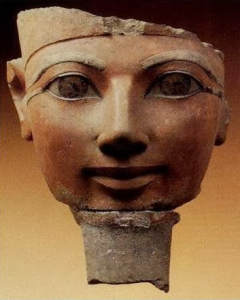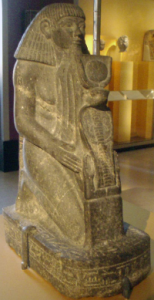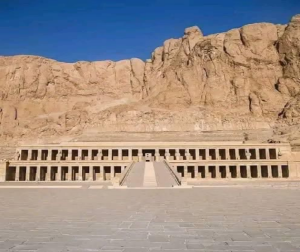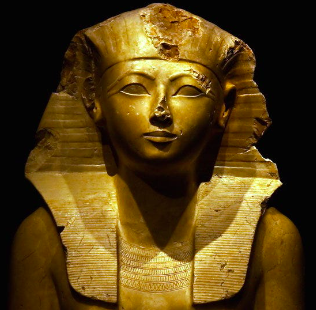Queen Hatshepsut
Queen Hatshepsut was one of the most significant rulers in Egypt’s history. Her reign lasted approximately twenty years. She was the daughter of King Thutmose I, the wife of King Thutmose II, and the aunt and mother-in-law of King Thutmose III. When King Thutmose II died, his son Thutmose III was only seven years old. Due to her strong personality, Queen Hatshepsut made him a priest at the Karnak Temple to keep him away from the throne. Since she was not entitled to rule, the priests invented story of “the divine birth” for her. This tale described how the god Amun secretly visited her mother in the form of her father, King Thutmose I, and gave her the key of life. And because gods intermarry through the nose. Thus, the queen became pregnant with Hatshepsut, making her a direct daughter of the god. This story is depicted in the beautiful temple she built, known as the Deir el-Bahri temple, which was designed by her architect “Senenmut”. “Senenmut”, who raised her daughters, has a magnificent statue in the Egyptian Museum. She also had a tomb built for herself in the Valley of the Kings, connected by a subterranean passage to her temple. One of Hatshepsut’s most significant achievements was her famous expedition to the land of Punt (modern-day Somalia). She brought back frankincense, henna, ivory, and perfumes. These scenes are depicted on the second floor of her temple at Deir el-Bahri. Queen Hatshepsut also constructed a magnificent structure at the Karnak Temple, with two obelisks in front. One remains in its original place, while the other was broken, but its head was erected next to the sacred lake at Karnak in 2023. She also had a magnificent obelisk in Aswan, which was never completed and is therefore known as the unfinished obelisk. It is famous because although it was broken, it remained in its quarry in Aswan. The cause of Queen Hatshepsut’s death remains unknown.

Head statue of Queen Hatshepsut at the Egyptian Museum in Tahrir

Statue of Senenmut, architect of the Deir el-Bahari Temple






